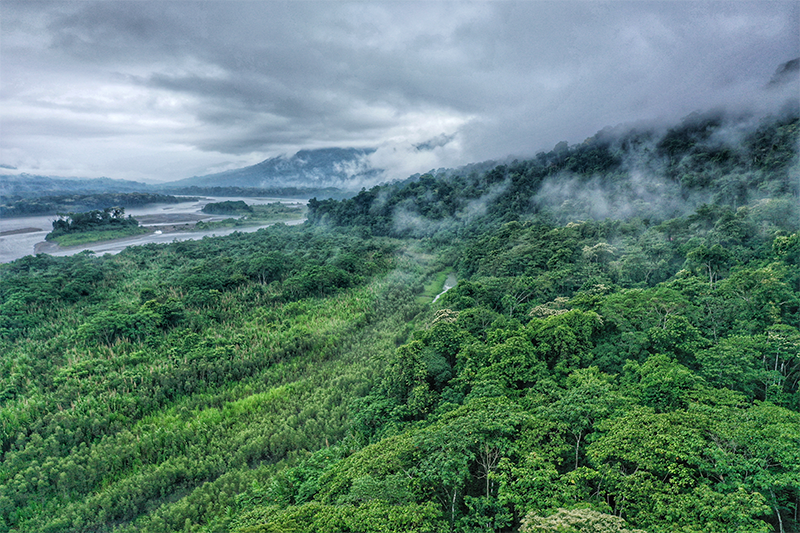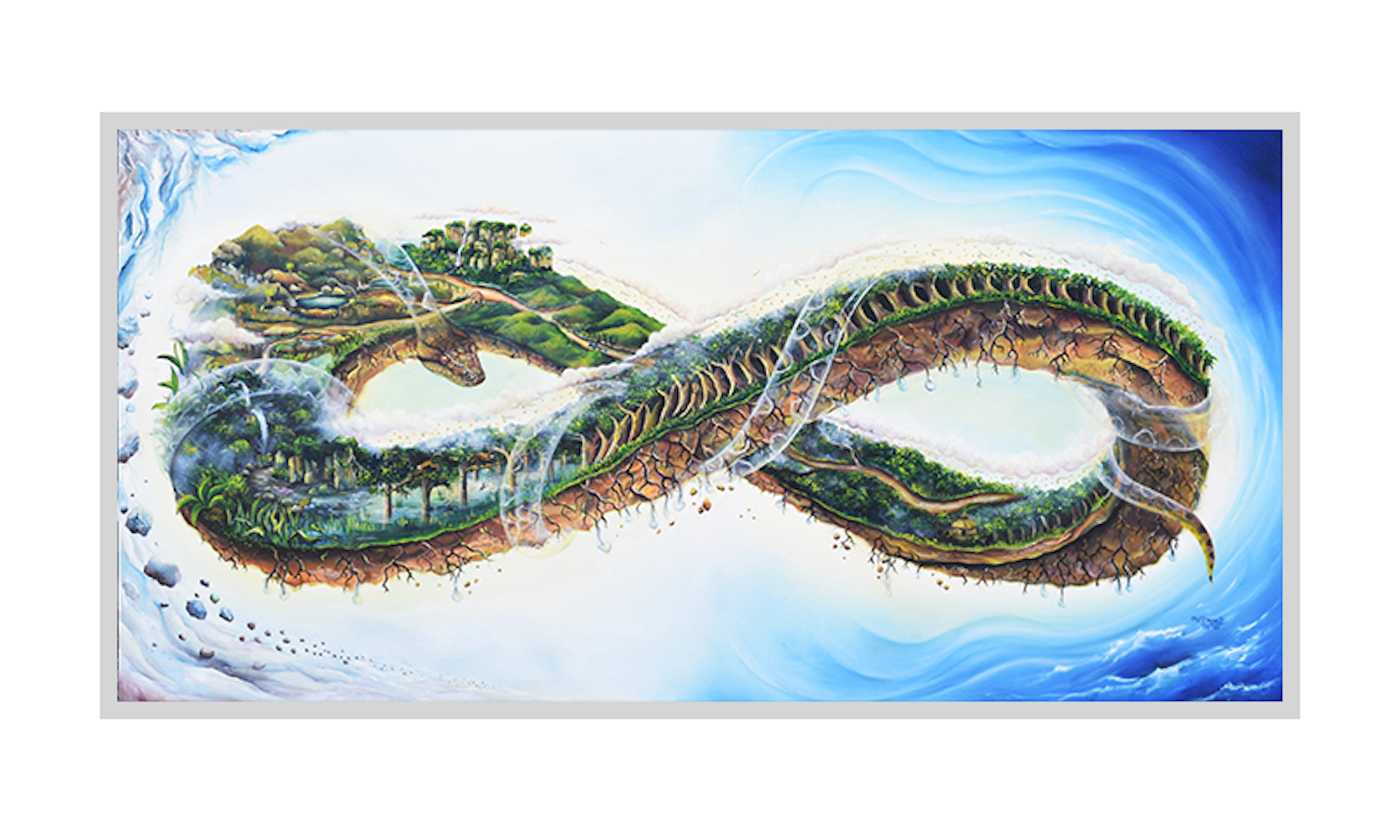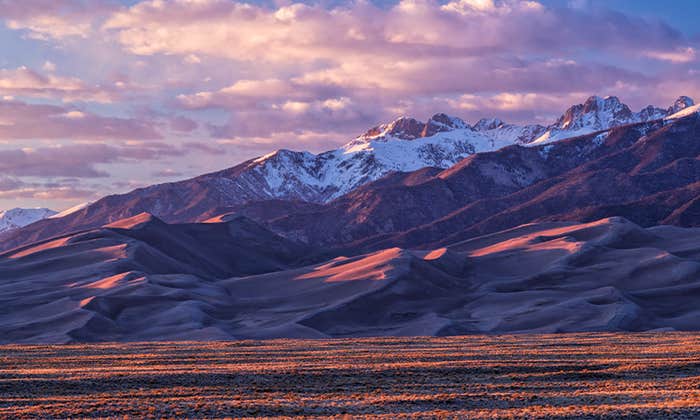High in the Andes Mountains, the mighty Amazon River begins. It trickles from glaciers and oozes from mountain wetlands. It gains momentum and volume and feeds into clear streams and muddy rivers that pass through high cloud forests and lowland valleys. The torrents of the waters carry nutrients through the vast Amazon River basin, some 4,000 miles across the rest of the South American continent.
At the same time, in the rainforest and delta estuaries, another, more ethereal—but no less essential—river is forming.
A single large tree in the Amazon rainforest can transpire about 264 gallons of water per day.
Across the Amazon rainforest, water is being sucked up by plant roots, transported through their bodies, and emitted or “transpired” from their leaves. In the air, this vapor rises and cools, condensing into clouds. Thus suspended, it becomes a sort of “flying river” of water vapor, flowing west, back toward the Andes. Along its own winding journey, its contents will fall as precipitation, forming upland rivers, wetlands, and mountain snow and icepack to feed, once again, the Amazon.
This interconnected cycle has been a sustaining force for some 10 million years. But the system appears to be faltering.

With tropical Andean glaciers quickly receding and high Andean wetlands threatened by climate change and unsustainable land use, the headwaters of the Amazon River are at risk. Its tributary rivers are being fragmented and depleted. Below, deforestation and land degradation in the Amazon basin are reducing the number of water-transpirers and threatening the westward flow of precipitation that ultimately forms the terrestrial river’s sources.
If this cycle breaks down and decouples, it could have profound implications for regional and potentially even global water cycles and climate, as well as for the biological and cultural diversity across much of the continent.
The Amazon rainforest is prized for its climate-regulating role of absorbing and sequestering prodigious amounts of carbon. But it might be the forests’ exhalation of water vapor that has an even larger impact on climate1 overall, through mass-scale cloud formation, moisture transport, and other large-scale connections2 of water and weather cycles.
A single large tree in the Amazon rainforest can transpire about 264 gallons of water per day, and the basin contains approximately 20 billion trees. This translates into billions of tons of water vapor rising every day from the Amazon canopy and flowing west—more than the amount of liquid water the Amazon River itself releases into the Atlantic Ocean each day.
Scientists first discovered this westward-moving flying river over the Amazon in the 1990s. A novel “biotic pump” theory3 suggests that water’s phase transition from vapor to liquid helps create—through the fundamental laws of thermodynamics—local wind currents that play a role in propelling these flying rivers toward the Andes. Along the way, moisture is recycled and recharged by the forests below.
The hydrological pump is at risk of shutting off.
Aiding this flying river process are the tiny compounds, known as biogenic volatile organic compounds, that are emitted from Amazonian vegetation itself. These organic gasses, such as isoprene, ascend from the rainforest canopy to the troposphere alongside the water vapor before being oxidized, through a complex pattern of reactions, into organic aerosols that assist in cloud formation and moisture movement.
“This has a general name of ‘flying rivers,’ but of course it is a much more complex transport mechanism,” says Paulo Artaxo, an environmental physicist who leads an interdisciplinary team of researchers at the University of São Paulo that focuses on the Amazon and climate change.
Artaxo knows this from analyzing data plucked from thin air, more than 17,000 feet above sea level. Working at a research station on Mount Chacaltaya in Bolivia, in the semi-arid Andes, some 2,000 miles from the mouth of the Amazon River, he and an international team detected tropical Amazonian forest organic aerosols4—as well as black carbon from anthropogenic fires in the basin, which can further accelerate glacial melt. Artaxo explains it’s these “isoprene organic aerosol particles, ice nuclei, and cloud condensation nuclei that are responsible for the very intense hydrological cycle in the Andes. There is a very close link between Amazonian organic compounds emitted by the plants and precipitation in the Andes.”

One way that link risks getting broken is if too many trees, these wellsprings of atmospheric moisture, vanish—due to mass deforestation and other forest degradation. Without enough of them, the hydrological pump is at risk of shutting off, which could have global consequences. The Amazon “has a critical role in regulating the regional as well as the global climate,” Artaxo says. “Changes in Amazonia such as deforestation will certainly have impacts all over the globe.”
Beyond the water itself, this is also a story woven by its companions—organic compounds above, and nutrients and sediments below. Andean rivers provide more than 90 percent of life-sustaining sediments to the Amazon River basin, and those nutrients are diminishing. The complex processes of weathering and erosion—which are guided in large part by long-term precipitation patterns—transform rocks in the Andes into soils and bio-available minerals. The strong currents of steep Andean rivers move rocks and soils downstream, at times through powerful landslides. Along the way, they break down these materials through biogeochemical processes into important minerals, including potassium, phosphorus, calcium, magnesium, zinc, and iron, that plant and animal life in the Amazon rainforest need to survive and thrive.
“Indigenous Peoples of the Amazon call this part of the Amazon Basin ‘the path of the anaconda.’”
Humans have been cutting off this other crucial circulation pattern, too. Dams along Andean-Amazon rivers are having wide-spread impacts on lowland ecosystems. Sediment-rich Andean rivers deposit their bounty along their courses, all the way to the mangrove forests of the Amazon delta. The inputs of these nutrient-rich sediments are especially important in the highly productive and expansive lowland Amazonian floodplains, where much of the transpiring vegetation is concentrated. More than 140 existing or under-construction dams have already fragmented six of eight major Andean-Amazon river basins. An additional 160 proposed dams for Andean-Amazon rivers are currently on the drawing boards.
Researchers say the dams have already upended the regulatory cycles of migratory fish, seasonal floods, and climate and hydrological cycles. Finding workable solutions on such a massive scale is an epic undertaking, they say, one that will take a shift in perspective, taking in all of the myriad dynamics of the inter-connectedwater cycles and ecosystems that reach across the continent.
This year, I traveled through the Andes and Amazon to research the hydrological and biocultural interconnections between headwater and transitional ecosystems. Along the way, I spoke to other researchers working to bring together traditional Indigenous knowledge with contemporary scientific approaches to find sweeping solutions—and to try to begin to move beyond the centuries of scientific dismissal of complex Indigenous knowledge systems.
I talked with Brazilian earth systems scientist Carlos Nobre, who helps lead the Science Panel for the Amazon as well as the planned Amazonia Institute of Technology. He said that these and many other groups are seeking “to merge knowledge [with Indigenous ethnic groups] because the Indigenous People, they have been living for 12,000 years in the Amazon, always with the forest standing.” Put another way, Francisco von Hildebrand, the president of Colombia-based non-governmental organization Gaia Amazonas, says “Indigenous Peoples of the Amazon rainforest have an absolutely clear understanding of the interconnectivity of ecosystems and life systems that go all the way from the Andes to the Atlantic.”

Several advocacy groups have come together into a larger coalition known as the North Amazon Alliance, which is fostering Indigenous-led, large-scale land conservation in order to support this essential basin-scale hydrological cycle. The group hopes to protect “the last strip of continuous healthy rainforest that connects all the way from the Andes across the Amazon to the Atlantic,” von Hildebrand says. The alliance already has more than 52 million hectares under its intercultural environmental management, including Indigenous territories, national parks, and other areas of “functional connectivity.” But, von Hildebrand says, “Our goal is to cover 200 million hectares to ensure biocultural connectivity and to protect the great flying river of the Amazon.” Many “Indigenous Peoples of the Amazon call this northern part of the Amazon Basin ‘the path of the anaconda,’” he says. “It is deeply embedded in their cultural knowledge, this northern part of the Amazon as an interconnected and interdependent region.”
Indeed, Indigenous Peoples of the Andes and Amazon also view themselves as part of nature and its interdependent hydrological and climatic processes, not separate from it.
“We do not live in the forest, we are of the forest,” Koreguaje leader Oliver Gasca told me from within his forested territory along the Orteguaza River, a tributary of the Amazon.
As we spoke in the dense, humid heat, the nearly opaque Orteguaza River flowed by. This land is in the gently sloping Andes-Amazon piedmont of Colombia, which lies within the Caqueta River basin, one of the Amazon basin’s largest and still-undammed Andean tributaries. “We are the guardians of the door to the Amazon,” he tells me.
And if this door closes, so too may the river in the sky, putting one of our planet’s most critical climate-regulating regions in even greater peril than we realized. ![]()
Daniel Henryk Rasolt is an independent interdisciplinary researcher and writer with a background in physics. He is the founder of Unbounded World, which provides an integrated approach to ecological and cultural preservation, and The Interplex, a new hybrid-style publication and collaborative community that focuses on the interdisciplinary, intercultural, and interconnected. Find him on LinkedIn and Twitter.
Lead painting by Vannessa Circe; “Flying Rivers” – Oil on Canvas
References
1. Artaxo, P., Hansson, H.C., Machado, L.A.T., & Rizzo, L.V. Tropical forests are crucial in regulating the climate on Earth. PLOS Climate 1, e0000054 (2022).
2. Avissar, R. & Werth, D. Global hydroclimatological teleconnections resulting from tropical deforestation. Journal of Hydrometeorology 6, 134-145 (2005).
3. Makarieva, A.M., Gorshkov, V.G., Sheil, D., Nobre, A.D., & Li, B.-L. Where do winds come from? A new theory on how water vapor condensation influences atmospheric pressure and dynamics. Atmospheric Chemistry and Physics 13, 1039-1056 (2013).
4. Zha, Q., et al. Oxidized organic molecules in the tropical free troposphere over Amazonia. National Science Review (2023).




























